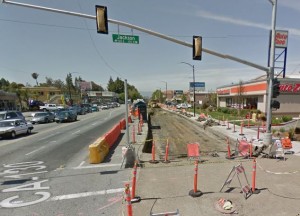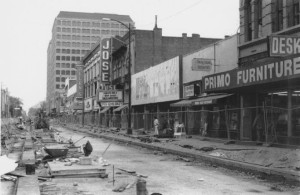
Bus Rapid Transit build at Alum Rock/Jackson in May 2015. Courtesy Google Maps.
There goes the Valley Transportation Authority’s (VTA) record of having projects built on-time and on-budget. By now, you’ve probably heard the news about how construction delays along Alum Rock Avenue in San Jose have delayed the Bus Rapid Transit (BRT) project until Summer 2016.
More on this issue – and how it parallels a past transit project in San Jose – follows.
Background
This story was initially reported by Jennifer Wadsworth of San Jose Inside back in August. One followup story on this issue from San Jose Inside was published in October, with another shortly afterward. Several months later, a followup story and an opinion piece on this issue from the San Jose Mercury News were published several months later.
On November 15, I was interviewed for this story by Joe Rodriguez, Staff Writer at the San Jose Mercury News. I expressed displeasure on the delays and their affects on businesses along Alum Rock Ave. in eastern San Jose. I also pointed out that this BRT project was approved by the voters as part of Measure A in 2000.
Forgotten History Now Retold
This is not the first time that construction problems and delays on a transit project in San Jose have hurt local businesses. Back in 1987 – years before VTA came into existence – Santa Clara County and the City of San Jose worked together to build the downtown San Jose “Transit Mall.” The Transit Mall runs down 1st and 2nd streets, between St. James Place and San Carlos Streets. VTA light rail and several bus lines like the 23, 66, 68, 72, 73, 181 Express and Highway 17 Express bus lines run along the Transit Mall today. Back in 1987, the project was managed by the City of San Jose.

Light rail “Transit Mall” construction along N. 2nd Street in 1987. Courtesy San Jose Memories.
This documented the cause and effects of the delays on completing the Transit Mall until 1988:
Q Why has the cost increased so much? A The city and contractor Weiss both acknowledge that some of the cost was the result of unforeseen problems, including a sealing mixture that did not work and inaccurate storm sewer and basement diagrams used to plan the job. Weiss contends that the city dragged its feet on more than 300 redesigns and plan revisions. Weiss also contends that the city has been too slow in considering his claims for more money. Those delays and the extra work are what cost him money, Weiss says. The city maintains that the Public Works Department is understaffed, but has been keeping pace with the change orders.Q When will the transit mall be completed and why is the completion date important? A The mall was originally scheduled to be completed Nov. 20. But it is now is 80 days behind schedule, according to city estimates. Bus traffic, rerouted during construction, is scheduled to return to First and Second streets on Dec. 7. Though city officials say that the mall is 92 percent completed, major work remains to be done on each block. Sidewalks outside the Fairmont Hotel were completed in time for the hotel opening last month. But scores of downtown businesses have folded and the remaining downtown merchants say their existence is threatened by every new delay.
This parallels the root of the delays of the VTA Bus Rapid Transit project back on July 9. At that time a “third-party” contractor hit a gas line without calling 811 first to have underground gas lines marked. One more reason why one should always “call before digging” on any construction project.
It appears VTA needs to put more emphasis on “responsible” in “lowest responsible bidder” when it comes to future transit projects. There are suggestions detailed in a letter from Chris Lepe, Silicon Valley Senior Community Planner at TransFORM, that give some solutions to this and future projects. In addition, the following are questions VTA should ask of current and prospective vendors as part of the bidding process:
- Has the vendor been fired from prior projects within the last few years? If so, why?
- For construction projects, is the vendor familiar with procedures to identify locations of all utilities before starting work?
- What is the vendor’s record of “change orders” for prior projects? If “change orders” took place, why were the change orders needed?
- Has the vendor filed for bankruptcy over the last few years?
- As for subcontractors the vendor may hire, what is their record, based on the prior points made above?
Also, citizens should better educate themselves on how bidding for public contracts at VTA works.
WHAT IS THE ISSUE?
Construction problems have caused delays on the Alum Rock BRT Project, resulting in harm to businesses in the area that VTA is trying to rectify.
WHO’S RESPONSIBLE AT VTA?
Ken Ronsse, Project Manager and Deputy Director. (408)929-2990 (project office) or (408)321-5680.
Conclusion
This is an issue that will continue to be monitored at the Silicon Valley Transit Users in 2016. More on what happened during and after the Transit Mall construction in 1987 – and the lessons it can provide VTA – will be highlighted in a future post.
Eugene Bradley
Founder, Silicon Valley Transit Users